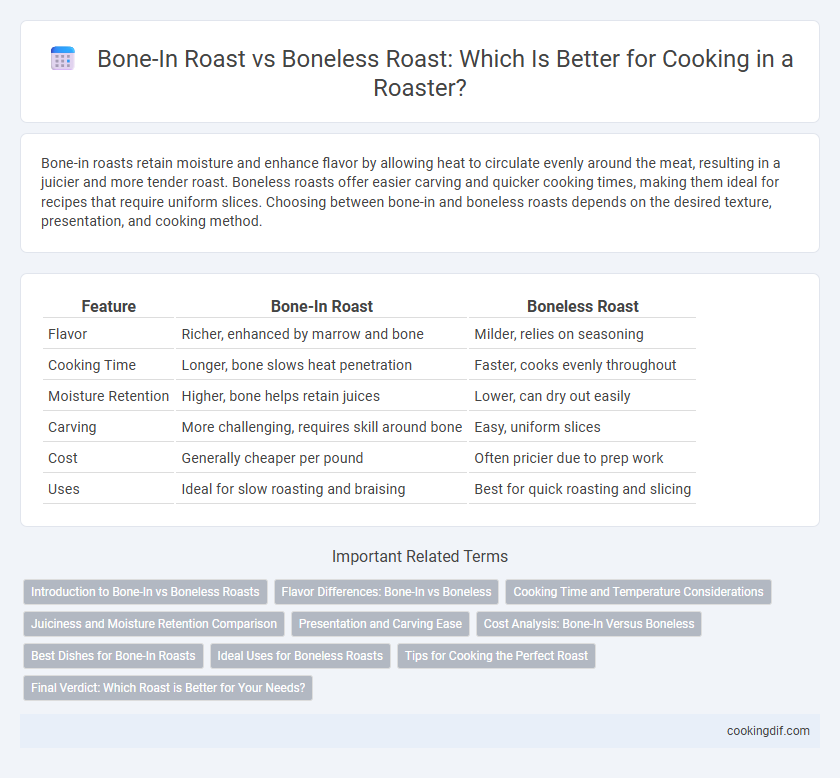Bone-in roasts retain moisture and enhance flavor by allowing heat to circulate evenly around the meat, resulting in a juicier and more tender roast. Boneless roasts offer easier carving and quicker cooking times, making them ideal for recipes that require uniform slices. Choosing between bone-in and boneless roasts depends on the desired texture, presentation, and cooking method.
Table of Comparison
| Feature | Bone-In Roast | Boneless Roast |
|---|---|---|
| Flavor | Richer, enhanced by marrow and bone | Milder, relies on seasoning |
| Cooking Time | Longer, bone slows heat penetration | Faster, cooks evenly throughout |
| Moisture Retention | Higher, bone helps retain juices | Lower, can dry out easily |
| Carving | More challenging, requires skill around bone | Easy, uniform slices |
| Cost | Generally cheaper per pound | Often pricier due to prep work |
| Uses | Ideal for slow roasting and braising | Best for quick roasting and slicing |
Introduction to Bone-In vs Boneless Roasts
Bone-in roasts retain moisture and enhance flavor due to the marrow and surrounding connective tissues, making them ideal for slow roasting methods. Boneless roasts offer easier carving and more uniform cooking, preferred for quicker preparation and consistent slicing. Both types demand attention to cooking times and temperature to achieve desired tenderness and taste.
Flavor Differences: Bone-In vs Boneless
Bone-in roasts deliver enhanced flavor due to marrow and connective tissues that infuse the meat during cooking, enriching its taste and juiciness. The bone helps retain moisture, creating a more succulent roast with a deeper, more complex flavor profile compared to boneless cuts. Boneless roasts offer convenience and uniform cooking but may lack the rich, robust taste developed from the bone's influence.
Cooking Time and Temperature Considerations
Bone-in roasts generally require longer cooking times and slightly lower temperatures compared to boneless roasts because the bone acts as an insulator, allowing heat to distribute more evenly and slowly. Boneless roasts cook faster and more uniformly, making them ideal for recipes that call for precise doneness levels or quicker meal preparation. Adjusting temperature by about 25degF lower for bone-in cuts helps ensure tenderness and juiciness while preserving optimal cooking time for even heat penetration.
Juiciness and Moisture Retention Comparison
Bone-in roasts retain more moisture during cooking due to the insulating properties of the bone, which helps distribute heat evenly and prevents drying out. The bone also adds flavor and juiciness by preserving the meat's natural juices. In contrast, boneless roasts tend to lose moisture faster, requiring careful cooking to avoid dryness but offering easier slicing and carving.
Presentation and Carving Ease
Bone-in roasts offer superior presentation with an appealing, rustic appearance that highlights the meat's natural shape, making them ideal for formal dinners or festive occasions. The bone enhances structural integrity during cooking, preventing the roast from collapsing and simplifying even slicing, which results in uniform, visually pleasing servings. Boneless roasts provide greater carving ease due to the absence of bone, allowing for quick, smooth slicing and better portion control, which is preferred for casual meals or buffet-style service.
Cost Analysis: Bone-In Versus Boneless
Bone-in roasts typically cost less per pound than boneless roasts because the weight of the bone adds value without increasing edible meat. Although boneless roasts provide convenience and uniformity in cooking, their higher price reflects the additional butchering labor and loss of weight from bone removal. Evaluating cost-effectiveness depends on whether the cooking process or portioning preferences justify paying a premium for boneless options.
Best Dishes for Bone-In Roasts
Bone-in roasts, such as prime rib or pork shoulder, excel in slow roasting and braising due to the bone enhancing flavor and moisture retention. Dishes like traditional prime rib roast, pork butt roast, and lamb leg roast benefit from the rich, succulent texture achieved by cooking with the bone in place. The presence of the bone also ensures even heat distribution, making bone-in roasts ideal for festive holiday meals and hearty family dinners.
Ideal Uses for Boneless Roasts
Boneless roasts offer versatility and ease of carving, making them ideal for recipes requiring uniform slices like pot roasts, briskets, and deli-style preparations. Their lack of bone allows for even cooking and marinating, enhancing flavor absorption, particularly in slow cooker and oven-roasted dishes. Perfect for meals where smooth texture and consistent thickness are desired, boneless roasts excel in recipes that benefit from precise portion control and presentation.
Tips for Cooking the Perfect Roast
Bone-in roasts retain moisture and enhance flavor by allowing heat to circulate evenly around the meat, making them ideal for slow roasting. Boneless roasts offer easier carving and faster cooking times, but require careful monitoring to avoid drying out. For the perfect roast, use a meat thermometer to ensure optimal internal temperature and let the roast rest before slicing to retain juices.
Final Verdict: Which Roast is Better for Your Needs?
Bone-in roasts retain moisture and add rich flavor during cooking, making them ideal for slow roasting and enhancing juiciness. Boneless roasts offer easier slicing and faster, more even cooking, perfect for recipes requiring uniform portions. Choosing between bone-in and boneless roasts depends on your cooking method, desired flavor depth, and serving preferences.
Bone-in roast vs boneless roast for cooking Infographic

 cookingdif.com
cookingdif.com